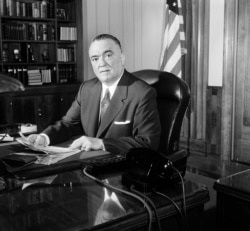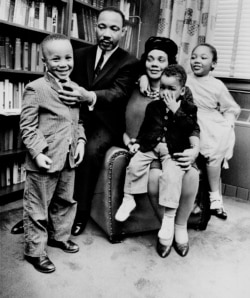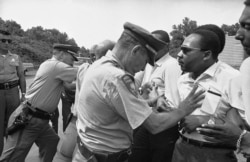There is a famous picture of American civil rights leader Martin Luther King Jr. seated for a ride on a public bus in Montgomery, Alabama.
The year was 1956 and King and other activists had led a boycott of that city’s bus system. The movement won an end to laws that restricted Black bus riders.
The picture shows King and another civil rights leader seated at the front of the bus. King is looking out the window, seemingly deep in thought. It was a victorious moment, but still very early in the fight for equality for African-Americans.
Ernest Withers took that picture of King, along with many others. Withers was a central documenter of the civil rights movement. He was also an informant for the United States Federal Bureau of Investigation (FBI).
A new documentary film, MLK/FBI, is about how the FBI sought someone close to King to watch and report on him. The film from director Sam Pollard shows how its two title subjects came to be enemies.
Pollard shows how FBI chief J. Edgar Hoover used the full force of the law enforcement agency to attack the nonviolent movement for civil rights in the 1960s. Wiretaps, blackmail and informants were all used in the operations to find legal or moral wrongdoing by King. The spying was part of a wider government campaign to find and destroy suspected communist influences in the U.S.
The activity against King “represents the darkest part of the Bureau’s history,” former FBI Director James Comey says in the film.
The documentary does not provide new information of major importance. There are not surprise witnesses or shocking discoveries. Most of the details — including King's sexual activities outside his marriage and the FBI’s use of Withers as an informant — have been known for years.
But that is not Pollard's interest. His exploration is expansive. He looks back to racist legal reforms that followed the Civil War and discusses the development of social weaponry based on Black sexuality. He explores how FBI agents were represented in popular culture as singularly powerful and just.
The film is mainly based on the book The FBI and Martin Luther King Jr.: From ‘Solo’ to Memphis, by historian David J. Garrow.
The most scandalous material comes late in the movie, after the filmmaker has presented the historical elements connecting the Civil Rights Movement and the U.S. government. By that point, the movie is close to over. But, the story of American intelligence operations that targeted Martin Luther King Jr. is suddenly very clear and frightening.
King's famous speech at the March on Washington took place on August 28, 1963. Two days later, FBI official William C. Sullivan, wrote about King, “We must mark him now as the most dangerous Negro in the future of this Nation…”
Pollard spoke to historians, reporters and other civil rights activists of the MLK period. However, most are only heard and not seen in the movie. The director also includes short parts of old movies and a lot of music.
The film’s messaging, however, is restrained by something out of the director’s control. It reports that King faced a “real emotional crisis” after the FBI sent his wife, Coretta Scott King, hurtful information about her husband.
And the film points out that the FBI secretly recorded King while he was dealing with the crisis. But the movie does not present anything from the FBI tapes. Those records are sealed until at least 2027.
I’m Caty Weaver
Mark Kennedy reported this story for the Associated Press. Caty Weaver adapted it for VOA Learning English. Mario Ritter, Jr. was the editor.
_______________________________________________________________
Words in This Story
title –n. the name of a book, song or movie
wiretap –n. a conversation recorded with a device used to secretly record speech on phone calls or similar communications
blackmail –n. threatening to tell secret information about someone unless they pay money or do something that is demanded
scandalous –adj. involving immoral or shocking things that a person has done or is believed to have done
lesson –n. an activity done in order to learn something
sealed –adj. to prevent something from being release or made known











